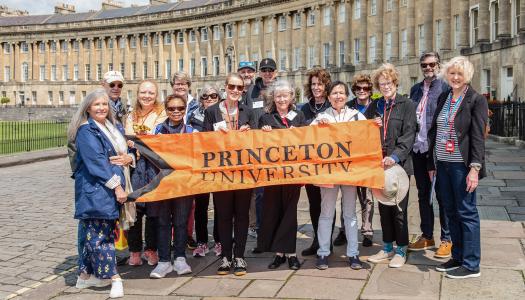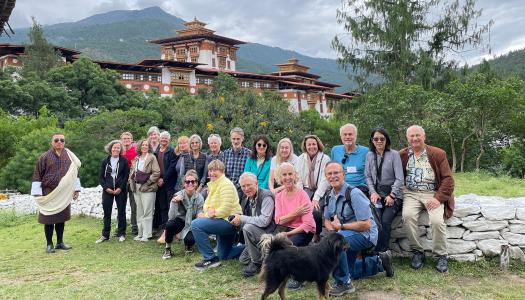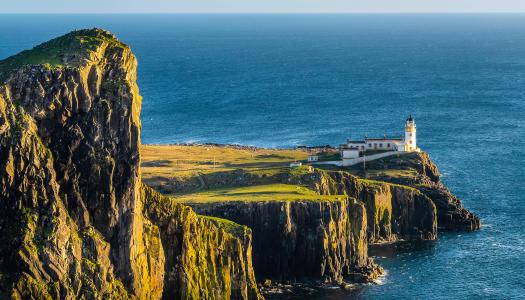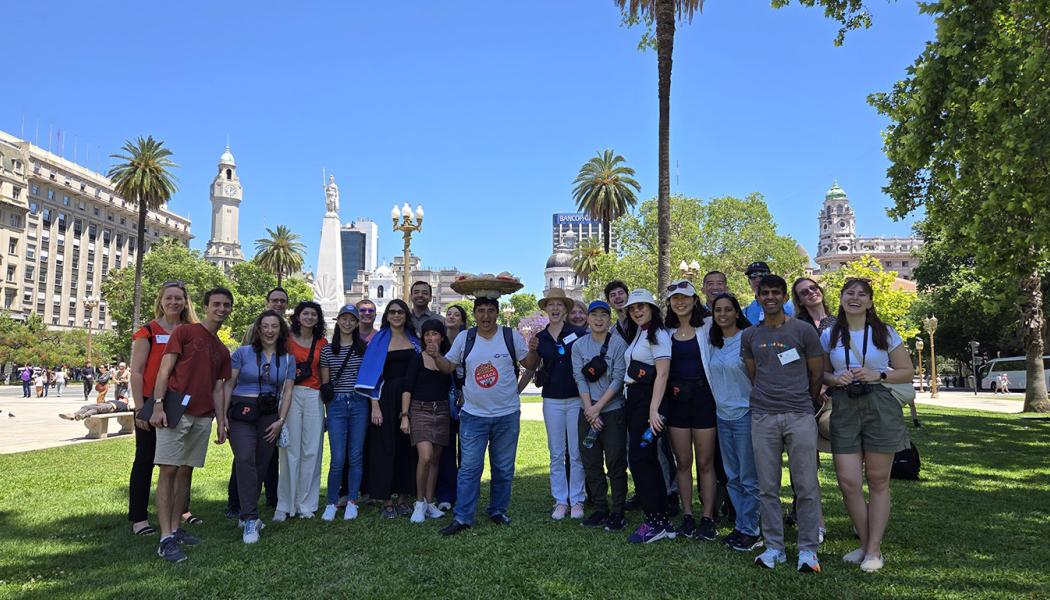
The Princeton Journeys Buenos Aires tour, crafted specifically for younger alumni, introduced Argentina through a local lens. Study leader Jordan Salama ’19 (far left) drew on friends and contacts, even conducting an impromptu interview with a passing bread seller (center).
Ally Cavazos ’19 had a few good reasons for joining the Princeton Journeys tour of Buenos Aires last November, and one of them was the outside chance of seeing a live capybara. She’d heard that these adorable, overgrown hamsters inhabit Argentina, so she figured: maybe.
“I was the person on the bus who was on capybara watch,” she confessed. “I was kind of obsessed. At one point, we had some time on the bus, and I started looking up capybara facts on my phone and just sharing them with everybody.”
Alas, “I don’t think we ended up seeing a capybara in person,” recalled fellow traveler Emily Reinhold ’21.
“She didn’t find any capybaras, because we were in, like, a huge city,” said Jordan Salama ’19, the author who guided the weeklong visit and assembled much of the itinerary. Despite the absence of gigantic rodents, the alumni who went on the Princeton Journey, designed especially for recent graduates, did experience unfettered access to local porteño culture that went far beyond typical tourism. This included seeing the cosmopolitan city’s European-influenced museums and hip neighborhoods, tasting local cuisine and wine, hitting a Latin pop concert, attending a thrilling professional soccer game accompanied by an Argentine sports journalist, staying up long past bedtime at an all-night tango hall, having a private talk with the U.S. ambassador to Argentina, taking a lush river cruise with environmental experts, and making new friends from Princeton and Buenos Aires.

“Princeton Journeys is such a unique opportunity to immerse yourself in another culture,” said Raj Hathiramani ’07, who made the trip with his wife, Aditi Gupta ’09 (they both had gone to Cuba in 2019 on another trip for recent alumni). “It’s incomparable to any other sightseeing. If I could do a Princeton Journeys trip every time I wanted to visit a new country, I would.”
The Buenos Aires tour offered a discounted rate for recent graduates and a tour guide who was one of them. Salama became a celebrated author shortly after graduating; his first book, “Every Day the River Changes,” about a journey he took along Colombia’s Magdalena River, was the 2022 Princeton Pre-read for incoming students. Although his Colombian expedition seemed too rough to replicate for a tour group, when the Princeton Journeys team reached out to him, he revealed that his next book, “Stranger in the Desert” (2025), was about a visit he had made to seek distant relatives in Argentina. A group journey to capital city Buenos Aires seemed promising, “and we just got started planning,” he said.
“The way the itinerary was constructed was very deliberate,” Salama said. “I wanted people to get to know Argentina in the way that I got to know Argentina, like they were going on a journey to meet family and their friends. We started out with more traditional walking tours of historic areas, and by the end we were having intimate conversations with people. For me, it was like telling a story over the course of six or seven days.”
Reinhold liked that the trip was targeted toward younger alums, “so I knew I’d have some peers there.” As a student, she briefly met Salama while sharing a class with his brother. She read his book to prepare, and it inspired her to arrange a first meeting of her own with a distant cousin in Buenos Aires.
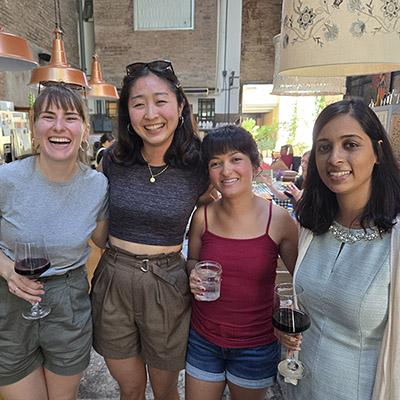
For Cavazos and her Princeton roommate, Victoria Ou ’19, it was another opportunity to globe-trot. “We had gone to Poland the summer before to see Taylor Swift on the Eras tour,” she said. “We had such a good time that, when we came back home, we were anxious to book more travel together.”
Hola, Buenos Aires
After the travelers settled in from overnight flights, quiet tours of historic sites came first: the Italian-style Teatro Colón opera house, which opened in 1908, and the dazzling Ateneo Grand Splendid bookstore in the heart of the city, built in an opulent former theater and often called the world’s most beautiful bookstore. The group was joined by Martin Marimón *17, who holds a Princeton Ph.D. in history and is a university professor in Buenos Aires and occasional professional tour guide. Marimón’s expertise in the city’s colonial past, diverse architecture and immigrant influences complemented the personal acquaintances Salama had made during his prior travels, connections that Salama made part of the tour.
“I never experienced a tour with that level of guests that would join us and share their knowledge and experiences,” Marimón said. “That was amazing.”
That first, extended arrival day ended with a Friday night concert at the Roxy, headlined by a Colombian trio that Salama knew. It set a lively pace for a week aimed at young travelers. “I was told that most Princeton Journeys days are done by 9 p.m., but we regularly went past midnight,” Salama said. “We really packed the days with a lot of activity.”
Saturday was tango night. Salama led the group to two milonga dance halls that were not on most tourist maps. The Princetonians learned a few moves, socialized and watched talented regulars cut up the floor. Recollections of how late the night went vary. 2 a.m.? 3? 4?
“It might have been past 3 a.m., because a few of us were waiting for this one couple who were going to come out and do a choreographed dance,” Reinhold recalled. “You could tell the locals were really excited. And they did just the most beautiful dances. It felt like we were part of something intimate.”
For Sunday lunch, the group had an Argentine cooking lesson at a private home, where they assisted a chef in grilling meats asado-style on a wood-burning brick oven and creating fragrant chimichurri sauce. Salama demonstrated how to prepare and properly drink matcha tea. Then they headed to the city’s Estadio Monumental, the largest sports stadium in South America, for a professional soccer game. Salama brought along Ariel Schvartbard, a journalist with national TV channel TyC Sports, who shared tips on the rules and traditions, including the passionate team songs that tens of thousands of rowdy fans sing in unison. The crowd pulsed and chanted and waved flags throughout the match as home team River Plate blanked Barracas Central, 3-0.
“That was like entering another world,” Hathiramani said. “The energy and songs of the crowd were electric. The match itself was captivating — a tactical, scoreless first half followed by multiple goals in the second half, during a thunderstorm. It was a truly immersive cultural experience that I’ll never forget.”
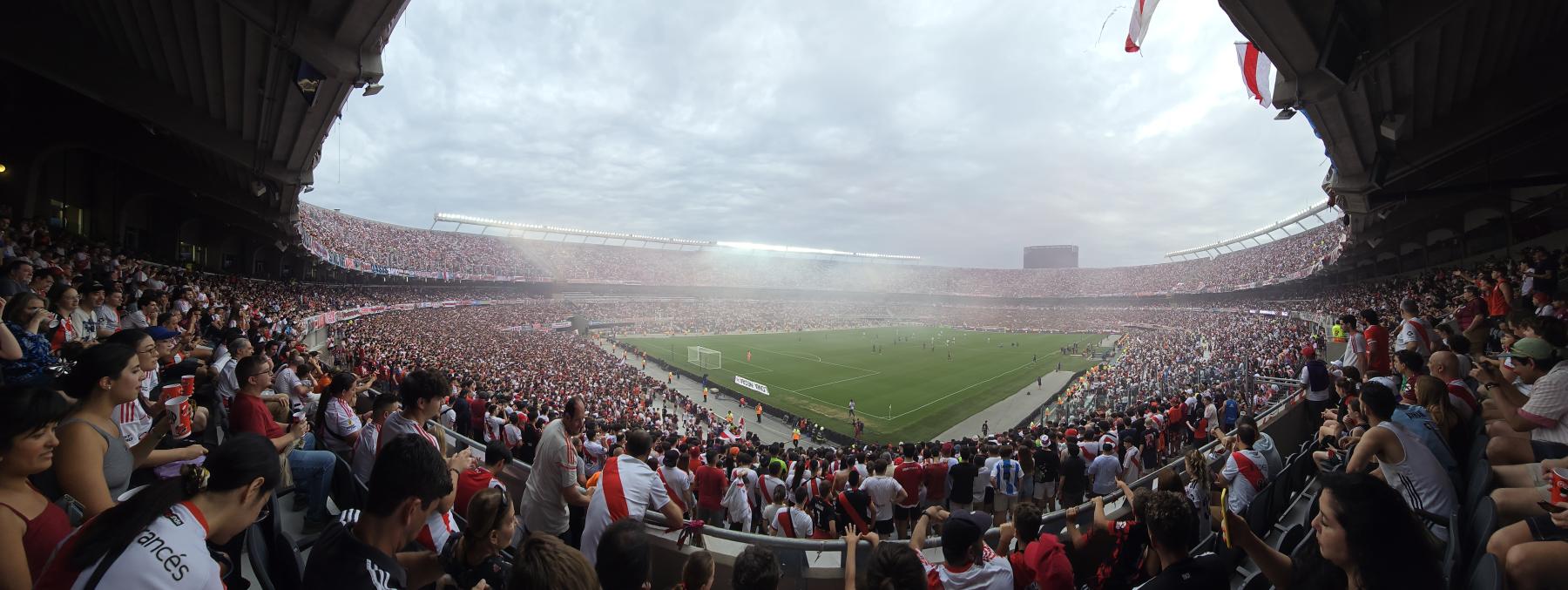
Into the Delta and the Barrio
The following day, the travelers took in the natural environment around the city, with a boat ride in the lush Tigre Delta wetlands area and lunch at another private residence. “The scenery was beautiful, and it was a nice way to relax after some busy days,” Reinhold said.
Once again, Salama augmented the standard tourist trip by inviting local guests to help navigate, including an environmental scientist, a climate journalist and an entomologist who discussed native insects and plants. “It felt like a very insider experience,” said Reinhold, who works as a sustainability professional.
On Tuesday, it was back to the city, with a guided tour of La Recoleta Cemetery, where Eva Perón is buried, and a visit to the neoclassical Bosch Palace residence of Marc Stanley, the U.S. ambassador to Argentina. Dinner that night was at the Buenos Aires home of Robb and Liz Maass (both of the Class of 1978), who have lived in the city part-time since 2003. They had hosted President Shirley Tilghman when she visited Buenos Aires in 2012, and Liz pulled together the Princeton Schools Committee chapter for Argentina and Uruguay, interviewing prospective students. Their apartment became a home away from home for the travelers, as they shared stories, empanadas, pizza and drinks. “It turned into a little party,” Liz said. The couple offered their knowledge of the city and marveled at what the visiting Tigers had already done. “I cannot believe the amount of stuff they packed into that trip,” Liz added.
The next day, the group walked the artsy La Boca neighborhood, known for its rainbow of multicolored homes and eye-popping street art and graffiti. They visited a print shop and talked with local artists. The group ate and drank a lot: grilled meats, choripán sausage sandwiches, a local liqueur called fernet, Argentine ice cream, pastries, coffee and yerba maté tea.
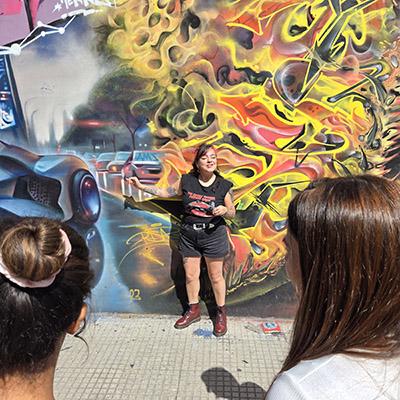
“It was like a running joke on the trip that I was the foodie, because almost every time we were somewhere, I could be found off in the corner eating snacks or drinking wine,” Cavazos admitted.
Salama used his instinct for storytelling in unplanned ways. As they strolled near the national capital’s presidential palace, called Casa Rosada (the Pink House), he saw a vendor selling pastries from a circular tray atop his head. “My great grandfather used to sell pastries on a circular tray on his head, in the center of Buenos Aires in the 1950s,” Salama said. “So I asked the guy if he’d mind talking to our group, and we’d buy some pastries.” The group enjoyed some local color and history that sightseers might never get, and they tasted chipa (a kind of cheesy bread).
Much of Salama’s “Stranger in the Desert” book is about the human need to tell and hear stories and the powerful role of storytelling as a thread connecting people across time and geography. “Our stories … are identities we create in worlds foreign and familiar, remembered now but forever at risk of being forgotten,” he writes in the book. He appreciated the chance to pass along some of Argentina’s stories and keep them alive with this young generation of travelers. It’s a perspective that turned a short vacation into something a little bit extraordinary.
“It was probably one of the most educational experiences of my life,” Cavazos said. “These trips are such a great way to experience parts of the world, especially to explore places that I maybe wouldn’t feel comfortable traveling to by myself.”
“The trip was a reminder of why I cherish my connection to Princeton University,” Hathiramani said. “From the care for alumni, to access to experts on climate change, international affairs and performing arts, it reflects the same dedication to fostering a deeper understanding of the world that I found in my time on campus.”
And Salama is thinking he might be able to make his Colombian trek work for his next Princeton Journeys tour. Travelers from his Buenos Aires trip are excited about the prospect. Because you never know what you’re going to encounter in a distant place — and capybaras live in Colombia, too.
